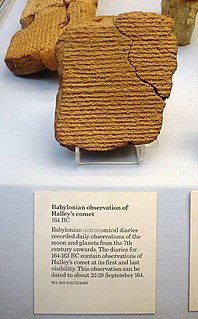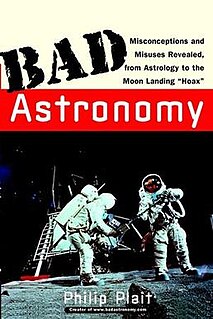
An eclipse is an astronomical event that occurs when an astronomical object or spacecraft is temporarily obscured, by passing into the shadow of another body or by having another body pass between it and the viewer. This alignment of three celestial objects is known as a syzygy. Apart from syzygy, the term eclipse is also used when a spacecraft reaches a position where it can observe two celestial bodies so aligned. An eclipse is the result of either an occultation or a transit.

Astronomy is the oldest of the natural sciences, dating back to antiquity, with its origins in the religious, mythological, cosmological, calendrical, and astrological beliefs and practices of prehistory: vestiges of these are still found in astrology, a discipline long interwoven with public and governmental astronomy. It was not completely separated in Europe during the Copernican Revolution starting in 1543. In some cultures, astronomical data was used for astrological prognostication. The study of astronomy has received financial and social support from many institutions, especially the Church, which was its largest source of support between the 12th century to the Enlightenment.

In astronomy, the new moon is the first lunar phase, when the Moon and Sun have the same ecliptic longitude. At this phase, the lunar disk is not visible to the unaided eye, except when silhouetted during a solar eclipse. Daylight outshines the earthlight that dimly illuminates the new moon. The actual phase is usually a very thin crescent.
Levi ben Gershon (1288–1344), better known by his Graecized name as Gersonides, or by his Latinized name Magister Leo Hebraeus, or in Hebrew by the abbreviation of first letters as RaLBaG, was a medieval French Jewish philosopher, Talmudist, mathematician, physician and astronomer/astrologer. He was born at Bagnols in Languedoc, France. According to Abraham Zacuto and others, he was the son of Gerson ben Solomon Catalan.
The saros is a period of exactly 223 synodic months, that can be used to predict eclipses of the Sun and Moon. One saros period after an eclipse, the Sun, Earth, and Moon return to approximately the same relative geometry, a near straight line, and a nearly identical eclipse will occur, in what is referred to as an eclipse cycle. A sar is one half of a saros.
The Hindu calendar refers to a set of various lunisolar calendars that are traditionally used in the Indian subcontinent and South-east Asia, with further regional variations for social and Hindu religious purposes. They adopt a similar underlying concept for timekeeping based on sidereal year for solar cycle and adjustment of lunar cycles in every three years, however also differ in their relative emphasis to moon cycle or the sun cycle and the names of months and when they consider the New Year to start. Of the various regional calendars, the most studied and known Hindu calendars are the Shalivahana Shaka found in South India, Vikram Samvat (Bikrami) found in Nepal North and Central regions of India, Tamil calendar used in Tamil Nadu, and the Bengali calendar used in the Bengal – all of which emphasize the lunar cycle. Their new year starts in spring. In contrast, in regions such as Kerala, the solar cycle is emphasized and this is called the Malayalam calendar, their new year starts in autumn, and these have origins in the second half of the 1st millennium CE. A Hindu calendar is sometimes referred to as Panchanga (पञ्चाङ्ग).
![Lunar node {{delete|[moon orbits the earth from West to East.the trajectory of moon that has been mentioned here is absolutely wrong.]}}point in space where the moon moves into the northern/southern ecliptic hemisphere](https://upload.wikimedia.org/wikipedia/commons/thumb/3/34/Lunar_eclipse_diagram-en.svg/320px-Lunar_eclipse_diagram-en.svg.png)
A lunar node is either of the two orbital nodes of the Moon, that is, the two points at which the orbit of the Moon intersects the ecliptic. The ascending node is where the Moon moves into the northern ecliptic hemisphere, while the descending node is where the Moon enters the southern ecliptic hemisphere.

Rāhu () is one of the nine major astronomical bodies (navagraha) in Indian texts. Unlike the other seven, Rahu is a shadow entity, one that causes eclipses and is the king of meteors. Rahu represents the ascension of the moon in its precessional orbit around the earth.

In Western astrology, astrological signs are the twelve 30° sectors of the ecliptic, starting at the vernal equinox, also known as the First Point of Aries. The order of the astrological signs is Aries, Taurus, Gemini, Cancer, Leo, Virgo, Libra, Scorpio, Sagittarius, Capricorn, Aquarius and Pisces. Each sector was named for a constellation it was passing through in times of naming.
Lalla was an Indian mathematician, astronomer, and astrologer who belonged to a family of astronomers. Lalla was the son of Trivikrama Bhatta and the grandson of Śâmba. He lived in central India, possibly in the Lāṭa region in modern south Gujarat. Lalla was known as being one of the leading Indian astronomers of the eighth century. Only two of his works are currently thought to be extant.
Śrīpati (1019–1066) was an Indian astronomer and mathematician, the author of Dhikotidakarana, a work of twenty verses on solar and lunar eclipses; Dhruvamanasa, a work of 105 verses on calculating planetary longitudes, eclipses and planetary transits; Siddhantasekhara a major work on astronomy in 19 chapters; and Ganitatilaka, an incomplete arithmetical treatise in 125 verses based on a work by Shridhara.

Ketu is the descending lunar node in Vedic, or Hindu astrology. According to some accounts in Hindu mythology, Ketu belongs to Jaimini Gotra, whereas Rahu is from Paiteenasa gotra; hence the two are entirely different entities with distinct characteristics but nonetheless are two parts of a common body. Ketu is generally referred to as a "shadow" planet. It is believed to have a tremendous impact on human lives and also the whole creation. In some special circumstances it helps someone achieve the zenith of fame. Ketu is often depicted with a gem or star on his head signifying a mystery light.

Babylonian astronomy was the study or recording of celestial objects during early history Mesopotamia. These records can be found on Sumerian clay tablets, inscribed in cuneiform, dated to around 1000 BCE.
A lunar station, also called a lunar mansion or lunar house, is a segment of the ecliptic through which the Moon passes in its orbit around the Earth. The concept was used by several ancient cultures as part of their calendrical system. In general, though not always, the zodiac is divided into 27 or 28 segments relative to the fixed stars – one for each day of the lunar month. The Moon's position is charted with respect to those fixed segments. Since the Moon's position at given stage will vary according to Earth's position in its own orbit, lunar stations are an effective system for keeping track of the passage of seasons.
Walter Gorn Old, born 20 March 1864 in Handsworth, England; died 23 December 1929 in Hove, England) was a notable 19th-century astrologer, who used the nom-de-plume "Sepharial", after an angel in the apocryphal Book of Enoch.

Bad Astronomy: Misconceptions and Misuses Revealed, from Astrology to the Moon Landing "Hoax" is a non-fiction book by the American astronomer Phil Plait, also known as "the Bad Astronomer". The book was published in 2002 and deals with various misunderstandings about space and astronomy, such as sounds being audible in space.
There are a number of planetary objects proposed in religion, astrology, ufology and pseudoscience whose existence is not supported by scientific evidence.
Astronomical chronology, or astronomical dating, is a technical method of dating events or artifacts that are associated with astronomical phenomena. Written records of historical events that include descriptions of astronomical phenomena have done much to clarify the chronology of the Ancient Near East; works of art which depict the configuration of the stars and planets and buildings which are oriented to the rising and setting of celestial bodies at a particular time have all been dated through astronomical calculations.
Planetary Stock Trading is a book written by a financial astrologer and fund manager Bill Meridian. It is a manual on how to spot stock market winners by their first trade horoscopes and their astrological transits. Meridian makes use of several concepts in the book which are not common in traditional astrology, including the use of declinations, the inclusion of asteroids and hypothetical planets, and the study of first trade charts instead of incorporation charts.
The Arcana: Or Stock And Share Key is a pamphlet by English astrologer Dr Walter Gorn Old, otherwise known as Sepharial. It is a work of financial astrology which aims to time the stock market by using transits to the natal chart of the New York Stock Exchange and London Stock Exchange, as well as the solar arc directions of both charts.



![Lunar node {{delete|[moon orbits the earth from West to East.the trajectory of moon that has been mentioned here is absolutely wrong.]}}point in space where the moon moves into the northern/southern ecliptic hemisphere](https://upload.wikimedia.org/wikipedia/commons/thumb/3/34/Lunar_eclipse_diagram-en.svg/320px-Lunar_eclipse_diagram-en.svg.png)




